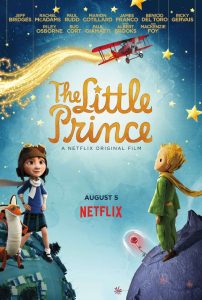
It troubles me that “The Little Prince” had a troubled release pattern here in the United States. Paramount, having acquired distribution rights for its stateside release, pulled the film from its planned theatrical release one week prior to the date. No reason was given, leaving many to ponder if it was due to poor marketing. If that’s the case, why wasn’t this, a wonderful and smart children’s film, given a proper marketing push? Was there fear that challenging children to think and be creative wouldn’t sell next to more commercially safe fare? Laika has done a commendable job of releasing their films theatrically, though I personally feel they should be even bigger box office hits than they are.
I don’t know the reasons for why Paramount pulled “The Little Prince” from its theatrical run, but I do know that Netflix righteously stepped in and released it on their streaming service. I also know that, after viewing the film, I am thankful Netflix stepped in, as more eyes will be on a tremendous and thought-provoking animated adventure! One based on a popular novel by Antoine de Saint-Exupéry, though I guess not popular enough in the United States in Paramount’s eyes.
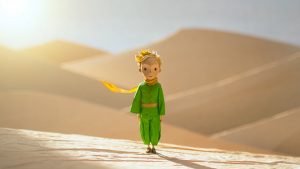
The film challenges children to think and, more importantly, challenges parents and teachers to teach them how to think, not what to think. The characters don’t have names, only referred to by their purpose. This is to reflect a society that rewards those on performance and not personality, robbing them of their identity in the process. True, the fantastical world that parallels the reality also follows this pattern, but only as a statement on societal structure.
The real world is a bleak existence ruled by grown-ups who’ve forgotten the innocence of childhood. A mother (Rachel McAdams) labors over getting her daughter (Mackenzie Foy) into a prestigious academy in order for her to have the best life possible. This is a life that is restricted to a set schedule: eat, sleep, study, repeat. Personal time with a friend is reserved a year from now, on Thursdays, from one to one-thirty. Does this resemble a child’s view of adulthood to you? It should!
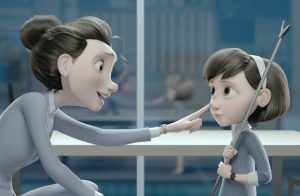
After the daughter fails to get into the prestigious academy via flubbing a question (she had prepared for a different one), her mother’s last gasp at entry is to move into the wealthy neighborhood to force her admittance. This is only in their budget due to having to move in next door to a kooky aviator (Jeff Bridges), the black sheep of the town. Every house on the street is a bland architecture of gray, but his stands out as one resembling a treehouse.
The aviator is an outcast, but quickly befriends the little girl during her summer vacation following a mishap in his attempt to fly his plane in his background, going through the neighboring house and not into the sky. He regales her in the story of the Little Prince (Riley Osborne), a lonely boy on a desolate planet who befriends the aviator after a crash landing. Immediately, the little girl begins to question the factuality of the boy’s living condition, humorously missing the point.
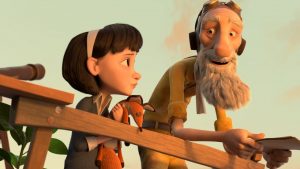
“The Little Prince,” the story within this film, the novel the film is based on, and the film itself is about perception. Its intention is to teach children how to think by presenting them with a fantasy and making them draw their own perception of reality. The world of the little prince is make believe, so getting caught up in the hows and whys of his unrealistic journey is futile. What one is to do is decipher the emotional drive of the characters and bask in the creativity of the world created. To think outside the box in order to stand out and understand differing lifestyles and viewpoints. By thinking outside the box, a child can draw conclusions to complicated subject matters and develop personal thought and critical thinking. To shelter them from this in order to prepare them for a predetermined destination stunts them from developing an identity and, most importantly, individual thought. Without the latter, they will stumble in life when a curveball is thrown, just as the little girl did when prompted with a different question at the academy.
Take for instance the little prince’s relationship with the rose (Marion Cotillard). The two love each other, but their inability to understand and work around their differences causes them to drift apart. Why develop a relationship between a boy and a plant? Is it to represent that love is foreign to the little prince, hence why he sees anything that contradicts his perception of reality as different to him? When he discovers that the rose, whom he believed to be the only one of her kind, is actually one of a million, he is heartbroken. He feels lied to, that her being just like many others denotes her specialty. What makes her special is her personality and his feelings for her. She is special because she is his rose. Was my perception of their relationship correct? That is up for discussion which is the entire point.

The little girl’s reality and the little prince’s fable act parallel to one another. The aviator tells her the story in spurts to complement her personal growth. As the little prince ventures into the unknown, she does the same simply by digesting it. She is challenged by the realities of life, such as love and loss, with the harsh reality that permeates the finale of the little prince’s journey pushing her to question and feel. The second act, which is her fantastical journey to find the little prince, also has a harsh reality that permeates the film’s finale, making one question if her journey was real or make believe. In the end it doesn’t matter, as she has learned how to think, just as the children watching this film have.
The animation style is split into two. The real world is done in the now traditional CGI animation, technically sound and colorful, though rather plain overall. This is in stark contrast to the animation of the little prince’s story, made to resemble that of a picture with stop motion animation bringing the characters to life. When the two are combined, it is nothing short of wonderful! Kudos to Mark Osborne for directing the animation style as parallel to how the stories are told, and kudos to Irena Brignull & Bob Persichetti for adapting the novel into a smart and challenging screenplay!
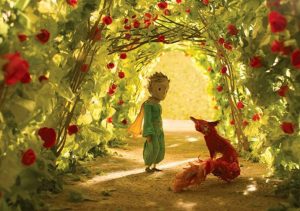
Last week, I praised Laika’s latest animated film, “Kubo and the Two Strings,” for being a smart and challenging animated film that wrote up to children, not down at them. I declared that film to be important in building character in children, delivering a fantasy they can get lost in and also learn from. I would not be surprised to discover that those at Laika were inspired by “The Little Prince,” as the novel and now this tremendous film adaptation share the same traits!
Final Rating: A+
